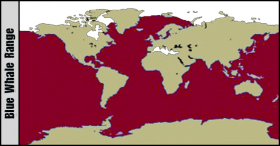Blue Whale
Balaenoptera musculus
World’s Largest Animal
Blue whales were abundant in nearly all the oceans until the beginning of the twentieth century. For more than 40 years, they were hunted almost to extinction by whalers until protected by the international community in 1966. A 2002 report estimated there were 5,000 to 12,000 blue whales worldwide, located in at least five groups. More recent research into the Pygmy subspecies suggests this may be an underestimate. Before whaling, the largest population was in the Antarctic, numbering approximately 239,000 (range 202,000 to 311,000). There remain only much smaller (around 2,000) concentrations in each of the North-East Pacific, Antarctic, and Indian Ocean groups. There are two more groups in the North Atlantic, and at least two in the Southern Hemisphere.
Blue Whale facts
- Females are larger than males and may weigh as much as 30-40 African elephants.
- The blue whale has a high, slender blow.
- Mating and calving must occur well offshore.
- Calves are six to seven meters at birth in the fall and winter.
- The calves nurse for seven to eight months to reach 16 meters.
- Nursing young can put on 90 kg a day.
- Sexual maturity is reached at about five years of age when the whales are 20 meters long.
- Blue whales migrate along both coasts between summer Arctic waters and winter southern waters
Related Topics
World’s Largest Animal
Blue whales were abundant in nearly all the oceans until the beginning of the twentieth century. For more than 40 years, they were hunted almost to extinction by whalers until protected by the international community in 1966. A 2002 report estimated there were 5,000 to 12,000 blue whales worldwide, located in at least five groups. More recent research into the Pygmy subspecies suggests this may be an underestimate. Before whaling, the largest population was in the Antarctic, numbering approximately 239,000 (range 202,000 to 311,000). There remain only much smaller (around 2,000) concentrations in each of the North-East Pacific, Antarctic, and Indian Ocean groups. There are two more groups in the North Atlantic, and at least two in the Southern Hemisphere.
Blue Whale facts
- Females are larger than males and may weigh as much as 30-40 African elephants.
- The blue whale has a high, slender blow.
- Mating and calving must occur well offshore.
- Calves are six to seven meters at birth in the fall and winter.
- The calves nurse for seven to eight months to reach 16 meters.
- Nursing young can put on 90 kg a day.
- Sexual maturity is reached at about five years of age when the whales are 20 meters long.
- Blue whales migrate along both coasts between summer Arctic waters and winter southern waters

































































































